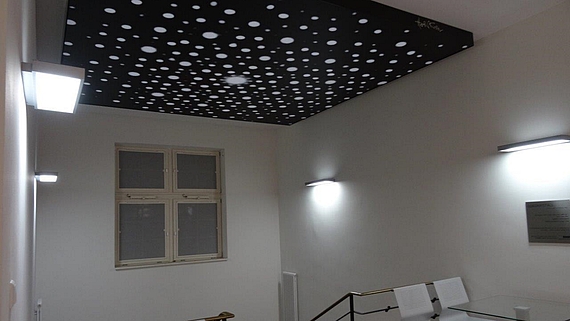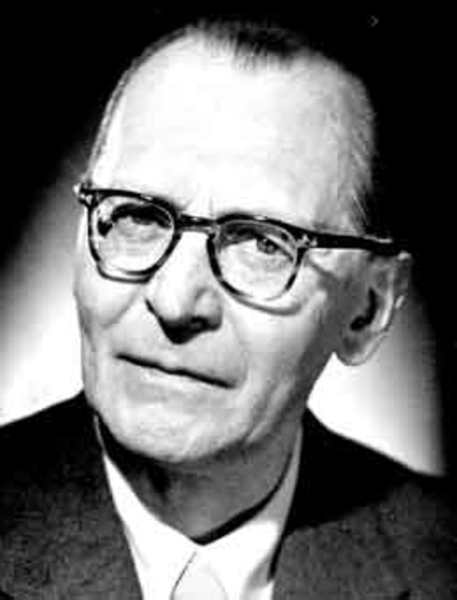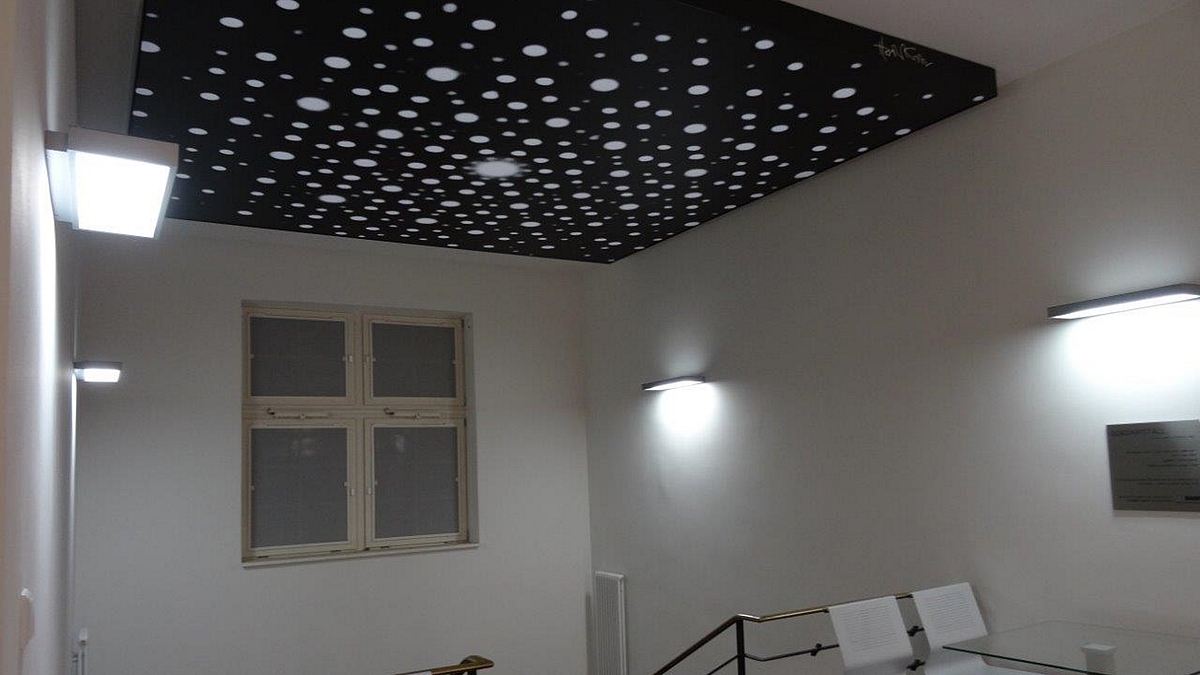Our institute: An overview

Our institute is located together with the other three chemistry institutes of Organic Chemistry, Technical Chemistry and Inorganic Chemistry in the district Hannover/Nordstadt and is currently one of the 20 institutes of the Faculty of Natural Sciences/Leibniz University Hannover. The historical building complex of the Hannover Chemistry was extensively renovated until 2016 and the buildings professionally restored. As part of the handover of the renovated building in 2015, an exceptional ceiling lighting system was installed in the stairwell of the Physical Chemistry.

The light installation in the institute building depicts the diffraction pattern of a quasicrystal as a ceiling image. The physicist Daniel Shechtman was awarded the Nobel Prize in Chemistry in 2011 for his discovery of the quasicrystal. Crystal structure analysis with diffraction methods is indispensable for chemical materials research. Sir Harold Kroto developed the artistic model for the quasicrystal ceiling picture. He reported on the diffraction pattern of a quasicrystal at the opening of the institute. The British chemist with German-Jewish roots not only received a design prize at a young age, but as a discoverer of fullerenes he also contributed to the initial spark of nanochemistry and, together with his research colleagues, was awarded the Nobel Prize for Chemistry in 1996.
Research at the institute
The institute is home to a large number of working group that conduct research in various fields of physical chemistry and electrochemistry. There are numerous interdisciplinary cooperations with industry and research, which is reflected in active third-party funding and participation in several joint projects. Local cooperation partners include, for example, the German Institute for Rubber Technology (DIK), the Laboratory for Nano and Quantum Engineering (LNQE), the Laser Centre Hannover (LZH), the Institute for Solar Energy Research Hameln (IFSH), the Biomolecular Drug Centre (BMWZ), as well as other universities in Lower Saxony.
History of the institute
1831
Back in 1831 the Höhere Gewerbeschule was founded in Hanover under the chairmanship of Karl Karmarsch, the forerunner of today's university. The Welfenschloss has served as the main building since 1879.
Since the summer semester of 1894, the Royal (Prussian) Technical University of Hanover has for the first time offered courses in electrochemistry. At this time this branch was already used in industry. The word electrochemistry was therefore perfect for the then flourishing electrotechnical and chemical industry.
The common economic interests and the associated demands for institutes and positions led to the foundation of the PCI.
1908

In 1908, Dr. Max Bodenstein was called to the TH for the newly created Chair of Electrochemistry, where he also became Professor of Physical Chemistry in 1911.
In his research, Prof. Bodenstein mainly dealt with reactions of the chlorine gas. Further areas were:
- the dissociation of hydrated sulphuric acid and ammonia
- the reactions of the nitrogen oxides
- the photochemical polymerization of anthracene
- the diffusion of cathodic hydrogen through iron and platinum
- the physical-chemical basics of zinc production in metallurgical plants
But his cooperation in the German Atomic Weight Commission also enjoys special attention.
In 1923 Bodenstein followed a call to the Friedrich Wilhelm University in Berlin.
1909
From 1909 to 1919 Friedrich Bergius was also a researcher at the institute. Decisive for his work were the high-pressure experiments carried out in 1911 on the conversion of coal with hydrogen. This was the beginning of his work on coal hydrogenation, which led to success in 1913; together with the TH. Goldschmidt AG in Essen, the laboratory tests were transferred to technical test facilities. In 1925, Carl Bosch acquired the patent rights to the Bergius process from BASF. Bergius and Bosch received scientific recognition for their research in 1931 when they were awarded the Nobel Prize for Chemistry.

1924
Hermann Braune was appointed as Bodenstein's representative successor. When he took over the professorship in 1924, he automatically became head of the Electrochemical Institute. In 1930 he moved into the new building of the institute initiated by Prof. Braune. Among his most important scientific topics were:
- Raman spectroscopy
- electron diffraction
- Measurements of dipole moments
Together with his assistant Fritz Strassmann he worked on the solubility of iodine in CO2. This work forms the basis for the currently intensive worldwide research in the field of thermodynamics for supercritical and near-critical solvents.
Prof. Braune retired in 1955.
1926
Fritz Strassmann also worked at the institute at the time of Braunes. His field of research was saturation vapour concentration, which could be achieved with the aid of compressed, non-ideal gases. The dissertation based on this was the starting point for later important technical developments. Knowledge of the vapour density of sulphur made it possible to optimise the so-called Claus process.
However, in 1929 Strassmann moved to the Kaiser Wilhelm Institute in Berlin, where he played a decisive role in the clarification of nuclear fission together with Otto Hahn and Lise Meitner.

1930

The second researcher at this time was Friedrich Wilhelm Jost, who also habilitated under Braune. Jost was the classical physical chemist. He applied the general laws of physics to the complex situations of chemistry and thus gained guidelines for meaningful experiments. At the Hanover Institute, he was mainly concerned with
- solid reactions
- diffusive transport in the crystal
- photochemical reactions in hydrogen bromid
In addition, he began researching the kinetic problems of fast reactions, which also include the combustion processes of hydrocarbons.
In 1937 Jost left Hannover to follow the call of an extraordinary professor to Leipzig.
1945
In October/November 1943 the exemplary new building of the Physikalisch-Chemisches Institut, initiated by Prof. Braune, fell victim to the bombs. Only the laboratories in the cellar could still be used for scientific work. Therefore the whole institute moved to Hilkerode to a disused cigarette factory. As late as 1945, the outsourced equipment was returned.
Thanks to the clean-up work of the students of the lower semesters, an orderly internship operation was possible again as early as 1947.
1955

Rudolf Suhrmann took over the chair of Physical Chemistry at the TU Hannover in 1955 as Braunes successor. He was not only a tireless researcher, but also a conscientious teacher. In addition to his extensive scientific publications, the textbook "Physikalisch-Chemische Praktikumsaufgaben" (Physical-Chemical Practical Course Tasks) was published. Due to the catastrophic economic conditions after the war, the research had to be carried out with outdated instruments. As the situation improved at the end of the 1950s, Suhrmann brought the equipment park up to date. Thus the institute could profit from the stormy development in the equipment technology. New laboratories were built on the upper floor and in the former extension for the employees' apartments. Numerous awards crowned his life until his retirement in 1960.
1964
In 1964 Robert Haul stepped into Suhrmann's footprints. At the end of the 60s he arranged for an expansion of the teaching staff in the field of chemistry. This resulted in the separation of the chair into A (Cluster Chemistry) and B (Solid State Chemistry). Haul himself held the chair A, and together with his students he researched further problems of solid state research. In addition to catalytic processes and the reaction of atoms to solid surfaces of oxides, the field of adsorption kinetics was also dealt with. Prof. Haul retired in 1978. Translated with www.DeepL.com/Translator
1968

The chair B was taken over in 1968 by Gerhard Ertl. His work carried out in Hanover was mainly concerned with the adsorption and catalytic reaction of small molecules on metal single crystal surfaces. Ertl has been director of the Fritz Haber Institute of the Max Planck Society in Berlin since 1986.
His scientific achievements were awarded the Nobel Prize for Chemistry in 2007.
1971
As mentioned above, two departments have been established at the Institute. The Photochemistry Department was taken over by Hanns von Weysenhoff, who returned from the USA to Germany in 1971 from the Illinois Institute of Technology, Chicago. He deals with fluorescence spectroscopic investigations of radiant and non-radiative transitions at excited organic molecules in the gas phase and with investigations of ultrafast processes using picosecond laser spectroscopy methods.
The Department of Electrochemistry was headed by Horst Gentsch, who continued to investigate the chemisorption of nickel and carbon in particular. During this time he had turned his attention to the activation of hydrogen during the desorption of transition metal surfaces. Since 1978 he has held the chair of Physical Chemistry at the Gesamthochschule - University of Essen. His successor was K. Funke from Göttingen, who works in the field of solid state spectroscopy.
In this year the 70th Bunsentagung took place and this already for the second time in Hanover. At this conference, which was prepared by the Institute, the local scientists and those who had travelled here dealt with the topic "Surface structure of solids and adsorption from the gas phase".










